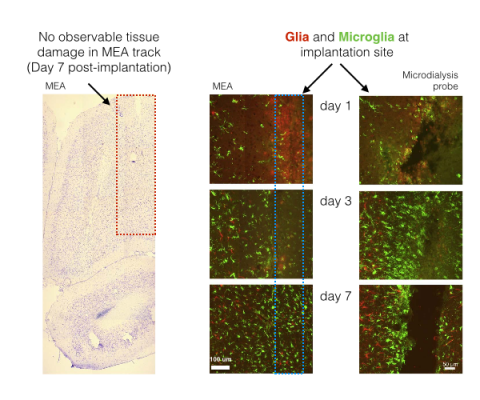The technology behind our in vivo recordings allows for rapid temporal measurements on a second-by-second basis. Data can be viewed immediately as it is recorded. No follow up sample processing is required except for any MatLab based analysis depending on your recording endpoints.
The second-by-second time resolution allows fast events to be captured, and the “self-referencing” feature of the biosensors guarantees a high degree of certainty in neurochemical identity.
Because of the reduced size and design of sensor and biocompatibility of materials used, the biosensors can be placed in discrete locations of the CNS with minimal tissue damage. Chronically implanted sensors can remain in place for several weeks or even months with little to no sign of encapsulation or gliosis.
“... chronic implantation of MEAs produces minimal damage to the CNS tissue and less extensive than the effects (100–600 μm) often produced by silicon-based microelectrodes (...). In addition, the MEAs produce far less damage to CNS tissue as compared to microdialysis probes.”
“ ... we were able to show histological data supporting minimal tissue damage caused by the ceramic MEAs for up to 6 months following implantation, supporting the potential for long term electrophysiological applications of the MEAs, which has been carried out in the hippocampus of awake behaving rats.”
From: Hascup et al. “Histological studies of the effects of chronic implantation of ceramic-based microelectrode arrays and microdialysis probes in rat prefrontal cortex” Brain Research (2009) 1291:12-20 (PubMed)
Continue to next section > > > Ceramic Based Microelectrode Arrays (MEA)

